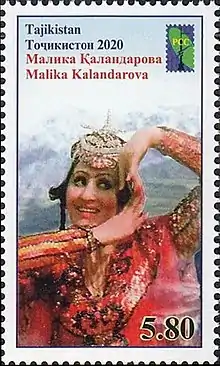Malika Kolontarova | |
|---|---|
 Kalontarova on a 2020 stamp of Tajikistan | |
| Born | Mazol Yashuvaevna Kolontarova Мазол Яшуваевна Колонтарова 2 September 1950 |
| Occupation(s) | Dancer, dance teacher, actress |
| Spouse | Ilyas Gulkarov |
| Awards | |
Malika Kolontarova (Tajik: Малика Қаландарова, Russian: Мазол (Малика) Яшуваевна Калантарова or Колонтарова; born 2 September 1950) is a Tajik–American dancer. She is known as the "Queen of Tajik and Oriental Dance."
Biography
Kolontarova was born with the name Mazol to Yashuva Kolontarov and Tamara Khanimova Kolontarova (both originally from Samarkand, Uzbekistan), a religious Bukharian Jewish family in Dushanbe, Tajikistan and was the youngest of her 5 sisters and 2 brothers. Mazol's father Yashuva wanted her to become a hairdresser like her older sisters, but Malika refused and wanted to become a dancer instead. Her father later on let her pursue a career in dancing.[1] Even though Kolontarova was rebellious as a child and had bigger dreams, she never forgot her roots, even when she became famous. Being Jewish was looked down upon in the Soviet Union and in Tajikistan but Malika proudly identified herself as a Bukharian Jew stating that since she is famous and admired, she does not feel the need to hide her Jewish identity. "Most Jewish people [in Tajikistan] say they are Tajik or they are Russian because Jews get no good work, no good pay," she says, "But once I'm famous, I'm not afraid. I say, 'Me Jewish.'"[2] Kolontarova was trained in dance by Gh. Valamatzoda and Remziye Bakkal.[3] Her director wanted her to change her name from Mazol to Malika. He said that Mazol sounded "too Jewish" and Malika means Queen in Arabic and Kolontarova danced like a Queen.[4]
Career
Malika began her career in 1965 with "Lola Dance Ensemble" and later went on to the Song and Dance Ensemble of the Tajik Philharmonic (Dushanbe). From the beginning, her dance moves were completely in sync with the music. Kolantarova became one of the most famous entertainers in the USSR and in Central Asia. She performed not only in Central Asia, but all over the Soviet Union and Asia. She was well known for her folk dances, and the dances which she created became a part of the Central Asian artistic culture. Kolontarova toured and performed different national dances in the countries such as Japan,[5] Afghanistan, Spain, Turkey, Russia and India. While in India, she appeared in some Bollywood films in the 1970s,[6][7] as well as films in the Tajik movie industry between the 60s and the collapse of the USSR.
Kolontarova married Ilyas (Ishaq) Gulkarov, a Bukharian Jewish doira player and "Honored Artist of Tajikistan." The two went on tour in Europe, Asia, and all over the Soviet Union.
Kolontarova was given the country's highest honor when she was named People's Artist of USSR in 1984,[8] becoming the only woman from Tajikistan to receive the title, after receiving the awards of "People's Artist of Tajikistan" in 1976 and "Honored Artist of Tajikistan" in 1972. According to Igor Moiseyev, a director of a world-renowned folk and character dance ensemble in the USSR, Malika is "an Eastern miracle" and she "made a revolution in Oriental popular dancing."
Emigration to the United States
Following the collapse of the USSR, Malika and her family moved to Queens, New York, in the United States in 1993 to escape the turmoil and poverty in Tajikistan. In America, Kolontarova continued her dancing career by opening up the "Malika's International Dance School" to teach young girls how to dance.[4]
Private life
Kolontarova and Gulkarov live in Rego Park, a neighbourhood of Queens populated by around 50,000 Bukharan Jews that has earned the nickname of Queenistan.[9] They have a son, named Mark,a daughter, Samira, and three grandchildren. Their daughter Samira is also a dancer who was part of the cast of Bellydance Superstars.[10] Samira was assigned male at birth and was named Arthur. Later in life, however, she underwent gender confirmation surgery (GRS) and had her name changed to Samira,[11] and participated in the Miss International Queen beauty pageant under the name Samira Sitara. She has started a music solo career under the name Samira Mazol. The family issues related to Samira's gender confirmation surgery were broadcast on Channel One Russia's talk show "Пусть говорят", when it was also revealed that Malika helped pay for the gender confirmation surgery and that she always dreamt of having a daughter[12]
Filmography
- 1961 — Зумрад —
- 1970 — Жених и невеста — Gulniora
- 1971 — Сказание о Рустаме —
- 1972 — Ураган в долине — Gultchekhra -Clip of the film (in Tajik).-
- 1984 — И еще одна ночь Шахерезады… —
- 1986 — Новые сказки Шахерезады —
- 1987 — Последняя ночь Шахерезады —
- 1989 — Шерали и Ойбарчин —
Awards
- People's Artist of USSR, 1984
- State Award of the Tajik SSR, 1984
- People's Artist of the Tajik SSR, 1976
- Honored Artist of the Tajik SSR, 1972
See also
References
- ↑ Benjamin Genocchio (20 August 2006). ART REVIEW; Ordinary People, Extraordinary Lives. New York Times
- ↑ Jon Kalish (17 October 2003) Immigrants in Their Own Words. The Forward
- ↑ Edward Allworth (1998). The Tatars of Crimea: Return to the Homeland : Studies and Documents. Duke University Press. p. 94. ISBN 0-8223-1994-2.
- 1 2 Sandee Brawarsky (16 November 2001). Central Asian Jews Create 'Queensistan' . New York Times
- ↑ Image. myspace.com
- ↑ Image. myspace.com
- ↑ Image. myspace.com
- ↑ "Famous dancers". bjews.com. Archived from the original on 4 September 2004. Retrieved 11 August 2008.
- ↑ Bukharian Jews Protect Their Culture in a N.Y. Enclave. Reuters. 21 October 2009
- ↑ Samir breaks taboo, becoming first gay star in Bellydance Superstars’ “Bombay Bellywood”. sdgln.com (27 September 2010)
- ↑ Сын Малики Каландаровой сменил пол. ozodi.org. 23 April 2015
- ↑ Пусть говорят выпуск. 1tv.ru (In Russian). 23 April 2015